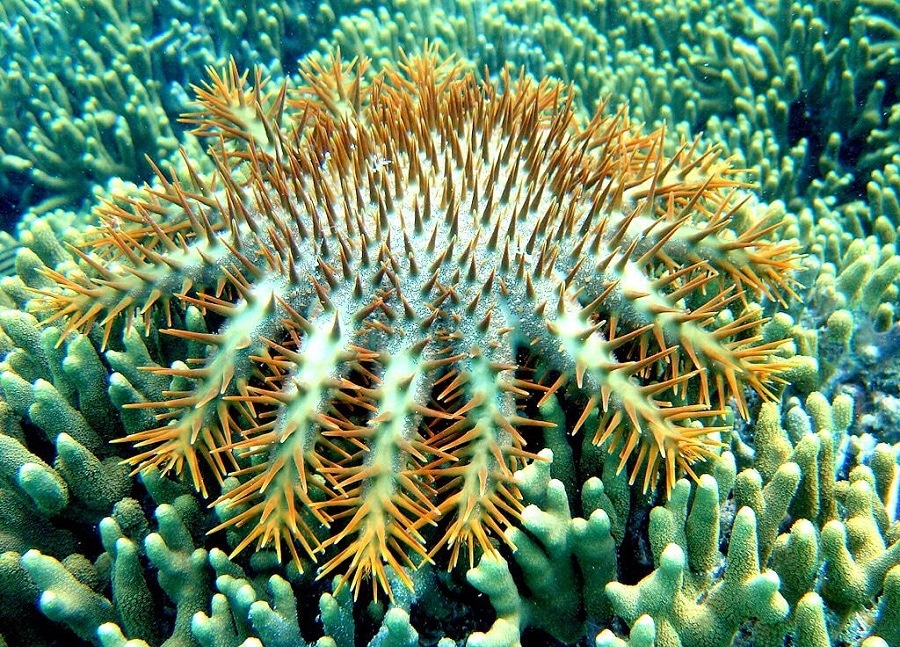Today we will talk a little about the Crown-of-thorns Starfish or Acanthaster planci, in scientific terms. This article is designed to offer you an accurate and summarized information about this strange starfish, whose venomous thorns are the main reason of their name.
Table Of Content
Main characteristics of the Crown-of-Thorns Starfish
The starfish are distinctive symbols of the sea, and probably the most harmless of all. However we can´t forget about the Crown-of-thorns which is also called the poisonous sea star.
These starfish are one of the most impressive marine species. Their bodies are quite similar to those of other starfish with a central disc and up to 21 arms. They also have two rows of tube feet that extend along each arm, which are completely covered with thorns. The size of adult crown-of-thorns starfish ranges between 25 cm and 35 cm. Light brown and pale green, are the most common colors of this species, although there are also some specimens of garish colors.
Habitat of the Crown-of-Thorns Starfish
These starfish inhabit in the Indian and Pacific Oceans, especially in Australia, although they can also be observed in subtropical areas from the red Sea and the east African coast across the Indian Ocean, and across the Pacific Ocean to the west coast of Central America
The poison of the Crown-of-thorns Starfish
These starfish in the same way than blue starfish , contain a sort of chemical compound named saponin, which is  poisonous for fish and human beings.
poisonous for fish and human beings.
The thorns of these starfish are quite sharped, which gives them protection against their predators or any other threat. Such thorns can enter any skin, causing in the victim a very intense pain, accompanied with nausea and vomiting.
Depending on where the thorn is inserted, it can cause a strong swelling and redness in the area, which means that you have to be very careful with them. The most advisable, is to go to the nearest doctor, so that he himself can take the necessary precautions, in order to calm the side effects that the poisonous sea star can cause.
Ecological Effect of the Crown-of- Thorns Starfish
These starfish commonly feed on the living tissue from the coral´s surface skeletons. When the proper balance is maintained in these natural structures, there is not reason to worry about, since the biodiversity is necessary.
However, in the case of outbreaks, which occur when the populations of the poisonous starfish is too high, the coral´s surface goes into decline.  The main reason is that the starfish broad their feeding areas, which results in continuous patches in the structure of the coral
The main reason is that the starfish broad their feeding areas, which results in continuous patches in the structure of the coral
This situation is currently occurring in the Great Barrier Coral Reef. Dr Hugh Sweatman from the Australian Institute of Marine Sciences offered a brief explanation of this situation:
The starfish is native to the reef but at high densities the results can be devastating, as thousands of the creatures munch their way through the coral. «Each starfish eats about its body diameter at night and so over time that mounts up very significantly,» Dr Sweatman said. This situation results in a lot of coral lost..
Other negative effects are listed following
- The appearance of filamentous algae becomes quite common
- In some occasions the predated surfaces are invaded by macroalgae, occupying the reef surfaces for long periods, which limits the recruitment by hard coral larvae.
The Australian Federal Government and the Association of Marine Park Tourism Operators; are working in order to control this situation, by decreasing the population of the poisonous starfish in specific areas.
The over fishing of tritons; which are the main predators of the Crown of Thorns starfish, as well as the quite fecund condition of the females of this species, are considered as the main reason of their sudden outbreaks.
In the meantime; we must be optimist about the success of the measures that have been taken, in order to maintain the proper ecological balance.


